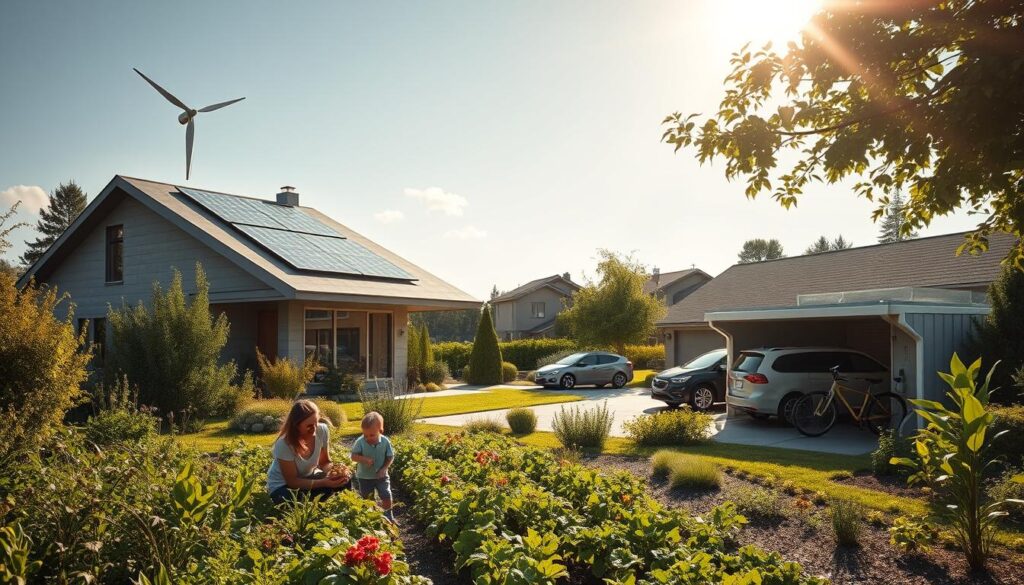Did you know that heating homes accounts for 13-14% of the UK’s total carbon emissions1? This staggering fact highlights the urgent need for sustainable living practices. As climate change impacts grow, adopting an eco-friendly lifestyle has become more critical than ever.
Eco-friendly living means making choices that reduce harm to the environment. It’s about using resources wisely and supporting practices that promote long-term sustainability. From energy-efficient appliances to renewable energy certifications, small changes can make a big difference.
Global standards like the Blue Angel and EU Ecolabel guide companies in meeting Sustainable Development Goals (SDGs). These labels ensure products and processes are environmentally responsible. By understanding these standards, consumers can make informed choices.
This article will provide actionable tips for reducing your carbon footprint. From daily habits to smart home solutions, you’ll discover how to live greener. Let’s explore how simple changes can lead to a healthier planet.
Key Takeaways
- Heating homes contributes significantly to carbon emissions.
- Eco-friendly living minimizes environmental harm.
- Global standards like Blue Angel guide sustainable practices.
- Small changes can lead to long-term sustainability.
- Actionable tips will help reduce your carbon footprint.
What Does “Eco-Friendly” Really Mean?
What does it truly mean for a product or practice to be labeled as ‘eco-friendly’? This term is often used in marketing and sustainability discussions, but its deeper implications are frequently misunderstood. At its core, “eco-friendly” means not harmful to the environment. It emphasizes reducing negative impacts on natural resources and ecosystems.

Defining Eco-Friendly and Its Key Concepts
The concept of “eco-friendly” revolves around the use of materials, processes, and methods that minimize environmental harm. For example, products made from recycled materials reduce the need for resource extraction and promote a sustainable cycle2. Similarly, production processes that conserve energy and water are essential for creating truly eco-friendly items.
Certifications like USDA Organic and Fair Trade Certified ensure that products meet strict environmental standards3. These labels help consumers identify items that align with sustainable practices. Understanding these key concepts is critical for making informed choices that benefit both the planet and future generations.
Eco-Friendly vs. Environmentally Friendly: Clearing the Confusion
While “eco-friendly” and “environmentally friendly” are often used interchangeably, there are subtle differences. “Eco-friendly” specifically refers to practices or products that do not harm the environment. In contrast, “environmentally friendly” is a broader term that includes actions or items that are beneficial or less harmful to the environment.
For instance, choosing reusable products over single-use items is an environmentally friendly method that reduces waste3. However, a product labeled as eco-friendly must meet stricter criteria, such as being made from sustainable materials and produced through low-impact processes.
| Term | Definition | Example |
|---|---|---|
| Eco-Friendly | Not harmful to the environment | Recycled paper products |
| Environmentally Friendly | Beneficial or less harmful to the environment | Reusable shopping bags |
By understanding these definitions, consumers can avoid greenwashing tactics and make choices that truly support sustainability. Whether it’s selecting products with eco-friendly packaging or adopting practices that conserve resources, every decision counts.
Implementing Daily Practices for a Sustainable Life
Every small action you take can have a big impact on the planet. By making mindful choices in your daily routine, you can reduce your carbon footprint and contribute to a healthier environment. Let’s explore practical steps you can take to conserve energy and minimize waste.

Energy Conservation and Reducing Your Carbon Footprint
One of the most effective ways to lower your environmental impact is by conserving energy. Start by switching off appliances when not in use. This simple habit can save significant amounts of energy over time.
Consider investing in Energy Star certified appliances. These devices use less energy and can reduce your utility bills by up to 30%4. Additionally, using LED light bulbs instead of traditional ones can drastically cut energy consumption.
Natural light is another excellent resource. Open your curtains during the day to reduce reliance on electric lighting. These small changes, when combined, can lead to substantial energy savings and a smaller carbon footprint.
Minimizing Waste and Embracing Recycling
Reducing waste is equally important for sustainability. The average American produces about 5.91 pounds of trash daily, with only 1.51 pounds being recycled4. By adopting better recycling habits, you can make a difference.
Start by separating recyclables from regular trash. Items like paper, glass, and certain plastics can often be recycled. Composting organic waste, such as food scraps, is another effective way to reduce landfill contributions.
Reusable shopping bags are a simple yet powerful tool. Each bag can prevent the use of hundreds of single-use plastic bags annually5. By making these changes, you can significantly reduce your waste and support a circular economy.
Remember, small daily actions, when compounded, lead to significant environmental improvements. Whether it’s conserving energy or embracing recycling, every effort counts toward a greener future.
How to Choose Eco-Friendly Products and Materials
Choosing the right products can significantly impact your environmental footprint. With 64% of consumers ranking sustainability as a top value driver, it’s essential to know what to look for6. From certifications to material choices, every detail matters.

Interpreting Ecolabels and Certifications
Ecolabels like the EU Ecolabel and Blue Angel help identify products that meet strict environmental standards. These certifications ensure that the product is made using sustainable methods and materials7. For example, ISO 14020 and ISO 14024 certifications indicate adherence to eco-friendly production practices.
Consumers are willing to pay an average of 9.7% more for products with these labels6. This shows the growing demand for transparency and accountability in manufacturing. Always check for certifications to ensure your purchase aligns with your values.
Comparing Materials: From Traditional Plastic to Bamboo
Traditional plastic takes up to 1,000 years to decompose, making it a major environmental concern8. In contrast, bamboo is 100% biodegradable and grows back within 3-5 years. This makes it a superior alternative for products like utensils, furniture, and packaging.
When evaluating materials, consider their design, durability, and overall quality. For instance, bamboo products are not only sustainable but also strong and long-lasting. Choosing materials like bamboo reduces reliance on non-renewable resources and supports a circular economy.
By understanding the source and lifecycle of materials, you can make informed decisions that benefit both the planet and future generations.
Smart Home and Energy-Saving Solutions
Smart homes are revolutionizing the way we consume energy, offering both cost savings and environmental benefits. By integrating advanced technologies, homeowners can significantly reduce their energy production needs and lower utility bills. These solutions not only enhance comfort but also contribute to a more sustainable future.

Integrating Renewable Energy Options
Renewable energy systems, such as solar panels and wind turbines, are becoming increasingly popular in modern homes. Solar panels, for example, can save homeowners between $10,000 to $30,000 over their lifetime, depending on system size and local energy costs9. Air-source heat pumps are another efficient option, reducing heating and cooling expenses by up to 50%10.
These systems not only lower energy bills but also reduce reliance on fossil fuels. By generating clean energy, households can significantly cut their carbon emissions. Investing in renewable energy is a long-term strategy that pays off both financially and environmentally.
Optimizing Insulation, LED Lighting, and Appliance Efficiency
Effective insulation is a cornerstone of energy-efficient homes. Adding attic insulation can reduce energy bills by 15-25%, depending on the climate9. Energy-efficient windows with low-E coatings further enhance savings by cutting heating and cooling costs by up to 30%9.
LED lighting is another simple yet powerful upgrade. These bulbs use 75% less energy than traditional incandescent bulbs and last up to 25 times longer9. Smart appliances, such as refrigerators and washing machines, can reduce energy costs by 2% to 9% annually10.
Smart thermostats are particularly effective, saving homeowners 10-12% on heating and 15% on cooling costs9. These devices adjust temperatures based on usage patterns, ensuring optimal efficiency. Combined, these measures can lead to substantial energy savings and a smaller environmental footprint.
| Solution | Savings | Example |
|---|---|---|
| Solar Panels | $10,000-$30,000 over lifetime | Depends on system size |
| LED Lighting | 75% less energy | Longer lifespan |
| Smart Thermostats | 10-12% on heating, 15% on cooling | Automated temperature control |
By adopting these smart home and energy-saving solutions, homeowners can achieve significant cost reductions while supporting sustainability. These innovations are not just about convenience—they’re about creating a greener, more efficient future.
Embracing Lifestyle Changes for a Greener Future
Living sustainably starts with conscious choices in your everyday routine. By adopting small but impactful habits, you can significantly reduce your environmental impact and contribute to a healthier planet. From dietary changes to waste reduction, every action counts.

Adopting Plant-Based and Local Consumption Habits
Transitioning to a plant-based diet is one of the most effective ways to lower greenhouse gas emissions. Livestock farming is a major contributor to these emissions, accounting for a significant portion of global harm11. Plant-based foods also require 50% less water and 80% less land compared to animal products11.
In addition, choosing locally sourced foods reduces transportation emissions and supports local farmers. This simple shift can drastically lower your carbon footprint while promoting community sustainability12.
Upcycling, Repairing, and Sustainable Daily Habits
Upcycling and repairing items instead of discarding them is another powerful way to minimize waste. Single-use plastics take an estimated 500 years to decompose, contributing to long-term environmental pollution11. By opting for durable, repairable products, you can reduce your impact on landfills.
Mindful consumption can lower individual waste by 30%12. Simple habits like using reusable bags, repairing clothes, and repurposing household items can make a big difference. These practices not only conserve resources but also save money in the long run.
“Small, consistent lifestyle changes can lead to significant improvements in individual eco-footprints over time.”12
| Lifestyle Change | Environmental Benefit |
|---|---|
| Plant-Based Diet | Reduces greenhouse gas emissions |
| Local Consumption | Lowers transportation emissions |
| Upcycling | Minimizes waste and landfill impact |
By embracing these lifestyle changes, you can play a vital role in reducing environmental harm. Even modest adjustments can create a ripple effect, leading to a greener future for all.
Conclusion
Adopting sustainable practices is not just a trend but a necessity for a healthier planet. By reducing emissions and minimizing landfill waste, we can significantly improve air quality and protect natural resources. Simple changes, like using energy-efficient appliances and recycling, can save money while lowering your carbon footprint13.
Countries like Germany and Sweden have shown that renewable energy can reduce emissions by up to 35%14. Similarly, households investing in smart technologies can cut energy bills by 30%13. These examples prove that small actions lead to big results.
Start today by making mindful choices. Whether it’s conserving energy or supporting sustainable products, every effort counts. Together, we can create a greener, healthier future for generations to come.
FAQ
What does “eco-friendly” mean?
How can I reduce my carbon footprint at home?
What are some ways to minimize waste daily?
How do I identify truly eco-friendly products?
Why is renewable energy important for a greener lifestyle?
What are the benefits of choosing sustainable materials like bamboo?
How can I adopt more sustainable daily habits?
Source Links
- The Ultimate 20 step Guide to Eco-friendly Living | Good Energy – https://www.goodenergy.co.uk/blog/the-ultimate-20-step-guide-to-eco-friendly-living/
- The Truth About What “Eco-Friendly” Actually Means – https://www.goodhousekeeping.com/home/a29830418/what-eco-friendly-means/
- What Does Eco-Friendly Really Mean? – https://lucentglobe.com/blogs/news/what-is-eco-friendly?srsltid=AfmBOopPwLvMEqpNHFNoIGQQ9eSJJCU9hMpmNUdSpdrdpVqerREHAVUn
- 11 Sustainable Living Ideas & Tips at Home | EarthKind – https://www.earthkind.com/blog/sustainable-living-ideas/?srsltid=AfmBOopqGsL7Va2PT3lhQsP-RAExa8AaVQahnblg9HDrl6SgpEQ1VoGC
- 12 Practical Sustainability Tips: Simple Changes for a Greener Future – https://orbasics.com/blogs/stories/how-to-be-more-sustainable?srsltid=AfmBOoqm9gCthayrmqJAhT-Wd6bSazEf1bdnLBRhGOpafmfWNizwrgTb
- 34 Eco-Friendly Products To Sell in 2025 for Sustainability – Shopify – https://www.shopify.com/blog/eco-friendly-products
- How to Recognize Eco-Friendly Products From Greenwashing? – https://www.winssolutions.org/how-to-recognize-eco-friendly-products-and-avoid-marketing-traps/
- 18 Eco-Friendly Building Materials That Help You Save Energy And The Earth – https://www.barbuliannodesign.com/post/eco-friendly-building-materials-list
- 7 Powerful Eco-Friendly Design Tips to Create an Energy-Efficient Home and Save Money – https://www.feeldesign.ai/en/post/7-powerful-eco-friendly-design-tips-to-create-an-energy-efficient-home-and-save-money
- Smart home technology saves money and helps protect the planet | IoT Now News & Reports – https://www.iot-now.com/2024/04/22/144080-smart-home-technology-saves-money-and-helps-protect-the-planet/
- 10 Simple Changes for a Sustainable Lifestyle – https://www.serenityridgemd.com/10-simple-changes-for-a-sustainable-lifestyle/
- 12 Practical Sustainability Tips: Simple Changes for a Greener Future – https://orbasics.com/blogs/stories/how-to-be-more-sustainable?srsltid=AfmBOorA0y4PXRtvS03P4tZEcNCuCdw4bXq0IkR2Toe9e34NJxm4bPhQ
- Why there is need for an eco-friendly lifestyle. – Environment Governance Institute (EGI) – https://www.egiuganda.org/2024/04/09/why-there-is-need-for-an-eco-friendly-lifestyle/
- What Is Eco-Friendly? Key Practices, Global Examples, and Future Innovations | What is Green Living? – https://whatisgreenliving.com/what-is-eco-friendly/
